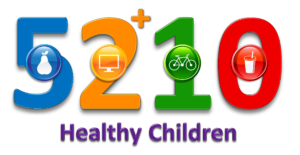October is National Children’s Health Month. Children learn about and model health behaviors from their families and their environments. The 5-2-1-0 health messaging campaign is a way to build and promote lifelong healthy habits for children at home and in the community.
Do you know the 5-2-1-0 message?
The 5-2-1-0 message recommends four healthy behaviors children should achieve each day:
 |
5 or more servings of fruits and vegetablesFruits and vegetables provide many nutrients and water without a lot of calories. Fruits and vegetables also contain fiber and a variety of phytochemicals that help prevent cancer, heart problems, and other diseases. Young children often reject new foods at first – it may take several exposures to a new food before they accept it. Keep trying! |
|
|
2 or fewer hours of screen timeReview guidelines on parenting strategies to ensure quality screen time (AAP, 2015) Screen time is free time that is spent in front of screens like televisions, video games, smart phones, and computers. It is possible to get enough physical activity and still engage in an unhealthy amount of screen time, so encourage your family to find other fun ways to spend their free time! |
|
|
1 or more hours of physical activityMoving your body is a great way to burn calories, improve your mood, boost your energy, prevent cancer and cardiovascular diseases, and help you sleep better at night, and it can be a lot of fun! Look for activities your family can enjoy together, so everyone can reap the benefits and help keep one another on track! |
 |
0 sweetened beveragesIt is important to drink fluids to stay healthy, but sweetened beverages add extra sugar and calories to one’s diet. Watch out for drinks with the following ingredients: sugar, honey, sweetener, syrup (e.g., corn syrup, brown rice syrup), and/or ingredients ending in “ose” (e.g., glucose, dextrose). |
The 5-2-1-0 behaviors are evidence-informed and are recommended by groups like the American Academy of Pediatrics, the U.S. Department of Health and Human Services, and the National Association for Sport and Physical Activity. All children, no matter their size, benefit from eating adequate amounts of fruits and vegetables, monitoring and limiting their screen time, being physically active, and avoiding sweetened beverages. Visit https://5210.psu.edu to access free tools and tips on how to help you enhance your child’s health and even start a community-wide campaign!
Additional Resources
American Academy of Pediatrics. (2015). Media and children communication [Toolkit]. Healthy Children. https://www.aap.org/en-us/advocacy-and-policy/aap-health-initiatives/Pages/Media-and-Children.aspx
Centers for Disease Control and Prevention. (2020, October 1). Children’s health month October 2020: Leading the way towards safe, healthy, and protective environments where children live, play, and learn! Your health your environment blog. https://blogs.cdc.gov/yourhealthyourenvironment/2020/10/01/leading-the-way-towards-safe-healthy-and-protective-environments-where-children-live-play-and-learn/
References
Clearinghouse for Military Family Readiness. (n.d). 5210 helping families lead healthier lives. https://5210.psu.edu/



